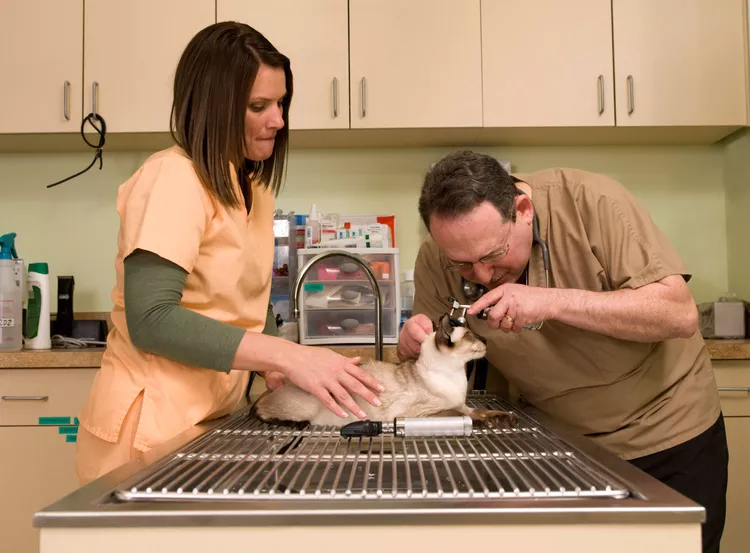Do you wish you could work for a pet-friendly company and bring your dog, cat, bird, reptile, or other pet with you to work every day? Many companies have adopted pet-friendly policies, from small businesses to large corporations. If your company isn't currently pet-friendly, you might be able to talk to your company's management team about allowing pets at work.
What Is a Pet-Friendly Workplace?
Research shows that pet-friendly workplaces lead to happier and more productive employees who stay with their companies longer. In light of these revelations, more and more companies are adopting pet-friendly policies, ranging from occasional bring-your-pet-to-work days to open access for pets every day.
Benefits of Pet-Friendly Workplaces
Many studies have explored the practice allowing workers to bring their pets to the office. Pet-friendly policies that allow pets in the office regularly or occasionally offer many benefits for both employees and employers. According to a study conducted by Nationwide and the Human Animal Bond Research Institute (HABRI), employees who work for pet-friendly companies:
- Feel more engaged with their work
- Are more likely to report a positive working relationship with their supervisor and co-workers
- Feel their company supports their physical health and wellness, as well as their mental well-being
- Are less likely to miss a day of work for well-being or recuperation
- Are more likely to recommend their place of employment to others
- Are more likely to stay with their company for the next 12 months
Types of Pet-Friendly Workplaces
Many different types of companies have adopted pet-friendly policies, from small workplaces to large corporations. A lot of pet-focused companies are pet-friendly, but many regular companies have also made pet-friendliness a priority. Pet-friendly policies might include allowing pets at work and offering time off to bond with a new pet, bereavement for the loss of a pet, stipends for pet supplies, and pet insurance through the company.
Some general types of pet-friendly workplaces include some pet-supply stores, pet groomers, veterinary offices, pet insurance providers, doggie day care facilities, and pet product manufacturers. If you’re looking for a new job and want to find a pet-friendly companies, Rover maintains a ranked list of dog-friendly companies. Some of the most dog-friendly companies include:
- Amazon
- Trupanion
- Kinship
- PetDesk
- StrideHealth
- Petco
- Nestle Purina Petcare
- WeWork
- VMWare Inc.
- Petsmart
- Procore Technologies
- Zogics
- TripAdvisor
How to Create a Pet-Friendly Workplace
If the company you work for doesn’t currently allow pets, talk to management about introducing a pet-friendly policy in your workplace. Present the benefits of pets at work, and offer to help create guidelines.
For instance, most pet-friendly companies require pets to be healthy, fully vaccinated and potty trained, and ask employees to fill out an application prior to bringing their pet to work. Policies can include the rules employees must follow. For instance, pets might be required to be on a leash, in a crate, or behind a pet gate when in the office, and employees might not be permitted to leave their pets unattended at any time.
Pet-friendly guidelines might also detail specific disciplinary action for disruptive pets, such as a three-strikes rule followed by temporary or permanent expulsion. Most pet-friendly workplaces also have a strict no-biting policy.
Consider the office space and work with management to identify outdoor potty areas and places where pets are or are not allowed indoors (for example, the cafeteria might be a human-only area).
Management might want to survey the staff to see if a pet-friendly workplace is something the majority wants before launching any new policies.
Best Practices for Pet Owners
If you work for a pet-friendly company, it’s important that you are responsible, courteous, and respectful of your coworkers, especially those who might not appreciate pets in the office. If pets become a nuisance to others, management might decide to eliminate the program.
Some best practices for pet owners who bring their pets to the office include:
- Ensure your pet is well-trained and well-mannered in an office environment. Not all pets are suitable to bring to work.
- If your dog is a barker, be respectful of your coworkers and do not bring them to the office.
- Don’t allow your pet to play with toys with bells or squeakers.
- Use a pet gate to keep your pet inside your office space.
- Never leave your pet unattended in the office.
- Unless your company has a free-roaming pet policy, keep your pet leashed or in a carrier when moving around the office.
- Take your dog out for sufficient potty breaks to prevent accidents.
- If accidents happen, clean them up promptly using a pet-specific cleaner. Alert management if a mess is more than you can handle so it can be sanitized appropriately.
Finally, consider your pet’s individual temperament. It should go without saying that reactive pets do not belong at work. But some pets simply do not enjoy being in an office environment. If your pet is scared, nervous, or withdrawn at work, or if they are overexcited, it might be best to leave them at home.




















